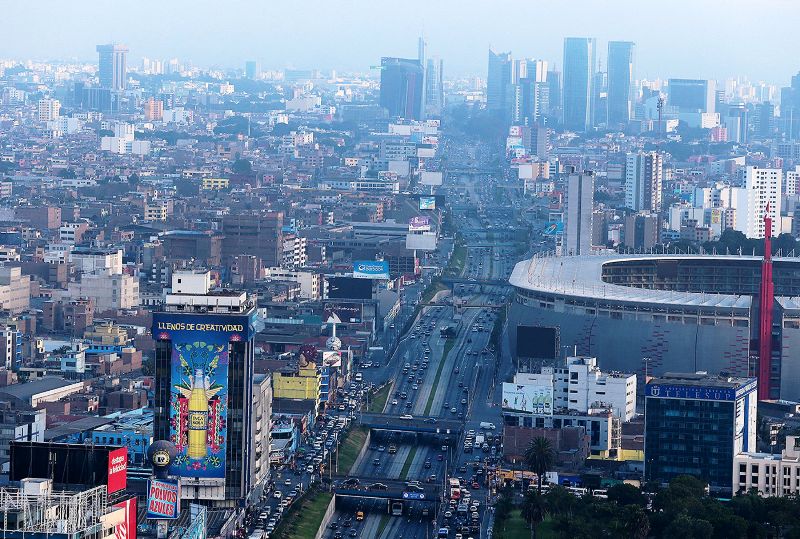For over a decade, emerging markets have been the darlings of the world economy. For many of the preeminent countries in that set, however, the boom period is over.
Russia and South Africa are both struggling to maintain positive growth. Brazil appears to be in contraction. China’s GDP growth fell below 7% for the first time since 2009. Others have similarly fallen in outlook as the IMF made a nearly across-the-board downward revision of its projections for emerging markets from those a year ago. Yet what are Peru’s prospects given such unfavorable circumstances elsewhere?
As with other emerging market economies, Peru faces headwinds in the form of lower commodity prices. The price of copper, Peru’s top mineral resource, has halved over the last five years. Down too are other exported commodities such as gold, zinc and natural gas. These tradeable resources account for 7% of the Peru’s GDP and helped boost economic growth to above 5% per year in the decade prior to 2014. Growth has since fallen below 3%.
Commodities fallout
The drop has been more than just a headline. Over 200,000 are employed directly in Peru’s extractive industries, and several million more are employed indirectly. Uncertainties in mining have reverberated throughout Peru in the form of reduced consumer confidence for all of 2015.
Beyond individual sentiment, Peru’s government has also taken note as income taxes and royalties from extractive industries account for 20% of government revenue. This proportion is even higher in the states of Moquegua, Tacna, Pasco and Ancash.
Then there is mining’s contribution to the Peruvian economy in the form of investment. Roads, structures and capital goods from both public and private funds to acquire natural resources comprise about a quarter of the economy.
Many of these roads, pipelines and machines direct Peru’s mineral products overseas. And many of them lead westward to China, which imports 40% of the world’s copper. Although the price of the metal is at six-year lows due to faltering manufacturing numbers in China, China’s imports in terms of volume have remained relatively stable, dropping less than 3% from the year before.
China and copper
But this scenario might not hold. China’s top copper smelters have agreed to cut production. Copper has been heavily featured as collateral in the carry trade. Tons of the metal sit idle in warehouses to back loans, a risky scenario which could unravel with dire consequences for copper-producing countries. Overcapacity is rampant in China’s secondary industry.
China’s careful act of economic re-balancing, although impeccably managed according to its official statistics, appears to be faltering by alternative measures such as electricity production and rail freight volumes. Fears of recession in China could become a stark reality at any moment.
Such an outcome, gradual or otherwise, will be felt by Peru. The World Bank estimates that a 1% reduction in China’s annual GDP growth will result in a similar reduction for Peru.
Dollarization
Besides the Far East, Peru’s economy is also threatened from the north in the form of the U.S. dollar. The dollar has appreciated substantially against emerging market currencies in recent months, including the Peruvian sol.
These countries are finding it more difficult to pay off loans denominated in dollars given their income is in local currency. Almost 50% of the credit on the books of Peru’s private sector must be paid back in dollars. Should the U.S. central bank raise its benchmark rate later this week, Peruvian debtors will need to spend more soles for the dollars needed to make interest payments, harming their financial position at the margin.
Fiscal policy
Despite these external challenges, internally Peru looks competitive across several measures. It has issued fewer bonds in foreign currency than neighbors such as Brazil, Colombia, Chile and Mexico, leaving it less susceptible to the default given dollar exchange rates. Its fiscal deficit is expected to remain stable at a manageable level, between 1% and 2% of GDP. Structural reforms to income tax rates are expected to attract further investment, and gross public debt is expected to fall as a percentage of GDP.
Again, there is mining. Peru continues to increase output, making up for declining commodity prices with volume. Within the next couple of years, volume will expand significantly when the Las Bambas and Cerro Verde expansion projects come online. Even if the prices of copper and other minerals decline further, Peruvian mines will remain profitable due to lower labor and energy costs relative to those other countries.
Barring troubles in China, Peru might once again regain 5% annual growth. But given mining remains key to Peru’s success, hiccups in China and the rest of the emerging markets will slow Peru’s growth to more moderate levels.
Fortunately Peru hasn’t dug itself into an economic hole like some emerging markets have.
Sources
Half of Peru’s mining revenues go to regional governments (EITI)
Fitch: Low Latam Copper Production Costs Shield to Lower Prices (Business Wire)
$50bn Nicaragua canal postponed as Chinese tycoon’s fortunes falter (Guardian)
Peru Economic Outlook (BBVA)
Peru – Economic forecast summary (June 2015) OECD
Global Growth Revised Down, Despite Cheaper Oil, Faster U.S. Growth (IMF)
Peru Consumer Confidence (Trading Economics)
CHART OF THE WEEK: GAP BETWEEN CHINA’S OFFICIAL STATISTICS AND OUR OWN VIEW OF REALITY CONTINUES TO WIDEN (Alpha Now)
Latin America and the Caribbean (World Bank)
An Assessment of the Competitiveness and Health of Peru’s Mining Industry (McKinsey)








